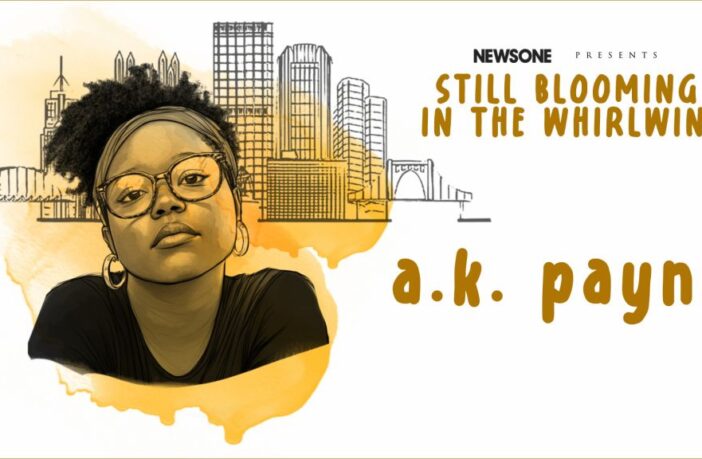Source: iOne Digital Creative Services
Step into the story circle.
The dimly lit, living room-like space rumbles with the hum of bantering voices as the smell of freshly cooked, family delicacies perform an intricate waltz with the sound of soft R&B harmonies synchronizing in the background.
Flanked by dozens of vintage photographs, each one holding a story, a memory – artists show off their own historical heirlooms in the midst of organic creation. The scene is warm and vibrant, yet comfortably cool. It’s familiar, defined by camaraderie often missing from traditional studios, offices, and artists spaces.
NewsOne Presents Still Blooming In The Whirlwind: Pittsburgh As A Black Cultural And Artistic Mecca
That is the welcoming atmosphere a.k. payne envisions – one where Black artists and community members come together to share, create, and connect. For payne, who goes by she/they, the act of gathering people to discuss ideas and histories is central to their art.
“I have prompts for writing monologues, scenes or poems that I offer into the room, kind of an interdisciplinary space where people get to create in different ways around Black stories or Black pictures,” she says.
Gatherings are not just about manifesting art; but about fostering a sense of community, exploring personal and collective histories, and envisioning futures rooted in the past.
The storyteller and playwright is deeply invested in the power of unified spaces, preferring the collaborative energy of rehearsal rooms over solitary writing. She insists being a playwright is inherently communal.
Black Story Circles, payne’s upcoming project, is an embodiment of these themes. In these creative ciphers, participants bring family photographs and stories, share meals, and engage in various forms of artistic creation—writing, painting, music, and dance.
Ekphrastic playwriting – creating plays inspired by visual arts, especially photography – is a driving force in their latest offering. payne sees photographs as a bridge between past and future, a way to explore and reimagine histories through a creative lens.
“When you take a photograph, or when folks took a photograph in the past, they were inherently imagining a future, someone holding that picture in their hand, whether that future is like in a few minutes or in a few years,” she said. “There is power and freedom in that.”
This process-oriented approach allows for deeper exploration and connection, both with the past and with each other, reclaiming family legacies history books leave out.
Although they descend from enslaved Africans brought to America in 1619 – an estimated 14 generations – most Black Americans are void of archival links to their family histories spanning several generations.
While the 1870 federal census first recorded formerly enslaved African Americans by name, many African Americans are still not able trace their family members to or beyond it.
Where slavery, Jim Crow and institutions of racism stripped documented Black genealogy from the fabric of American history, African American oratory and photographical tradition serve as formal archives.
Growing up in Pittsburgh, payne’s life has been steeped in stories. She depicts a child explorer uncovering the life of her late grandmother after whom she is named. Their work often explores themes of migration and movement, inspired by their family’s history in the city dating back to the early 1900s during the Great Migration.
While there have been exhibits, documentaries and the like showcasing Black family photos as an integral component of American history, the goal for payne’s Black Story Circles overall is not to produce a single work, but to create a space where the act of making is itself the product.
But for payne, Black Story Circles is as much about self-discovery as it is about community. A series of plays centering the countless photos in their great-grandmother’s archives is a personal motivation to manifest from the project.
Where photography and archiving history are foundational to her artistry, Afro-futurism is equally inspirational in payne’s craft, offering a framework to envision futures that transcend the limitations of the present.
payne’s Amani, a pivotal work in this genre, tells the story of a father and daughter striving to reach outer space. This play is part of a larger series, The Black Space Plays, which imagines Black audiences reaching for the stars, both metaphorically and literally.
Their foray into the genre is a natural extension of their passion for celebrating Black history.
“Imagining the past reminds me that like we existed before, which means there was a future that existed. There was a future that someone imagined back then that launches me into now,” payne says.
“That is integral to how I imagined myself creating, because sometimes I feel like imagining spaces that don’t yet exist.”
Similarly with Black Story Circles, payne strives for artists and the community to feel empowered, liberated by the act of taking a photograph and imagining a future where someone will hold that picture, admiring the past it represents.
For payne, Afro-futurism is not just about escaping the present but about creating possibilities. Incorporating it allows payne to create space or Black people to imagine worlds where they can exist freely, beyond the constraints imposed by society.
In their plays, characters often strive for moments of unencumbered existence, where she is not defined by the gaze of the outside world but by their own dreams and desires. The concept of freedom is central to payne’s work.
“So often the systems that we’re in or that have been created around black life, are oriented towards not allowing us to slow down or to be with each other,” payne says.
“Breath is so rooted in that. So often, we’re holding our breath and we don’t know it whereas freedom is the capacity to slow down, to witness, to spend time with one another.”
Black Story Circles is an extension of that purpose. African American family histories largely exist in the photo albums that lay stored away. With these photographs on display, their visual storytelling lives as testament to the perseverance of Black life, and an in-the-flesh celebration that artistry creates.
payne envisions expanding the jubilee Black Story Circles beyond Pittsburgh and the U.S., creating a diasporic network of interdisciplinary art-making communities.
By looking back at family history and the stories of the ancestors, payne hopes to create a future where Black voices and experiences are celebrated and where new possibilities can be imagined and realized.
“What we create in this present is intimately connected to who our people were, how we told stories,” she says. “Like our own museum, we begin to reclaim the stories our people told when a photo on display is the foundation of that art.”
Kenya is an award-winning, freelance multimedia journalist with more than a decade of experience covering news, politics, sports and more – with a concentration on culture and identity.
SEE ALSO:
Marques Redd And Mikael Owunna Are ‘Pulling Back The Veil On What It Means To Be African’
Between Race, Industry And Artistry
10 photos



